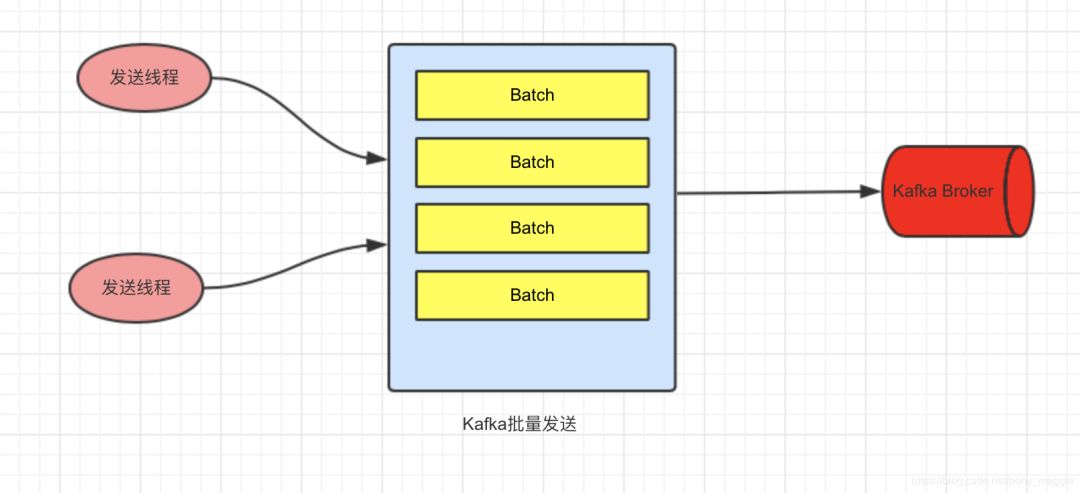
 作者 | 犀牛饲养员
作者 | 犀牛饲养员
责编 | 徐威龙
封图| CSDN 下载于视觉中国
最近看kafka源码,着实被它的客户端缓冲池技术优雅到了。忍不住要写篇文章赞美一下(哈哈)。 注:本文用到的源码来自kafka2.2.2版本。 背景
当我们应用程序调用kafka客户端 producer发送消息的时候,在kafka客户端内部,会把属于同一个topic分区的消息先汇总起来,形成一个batch。真正发往kafka服务器的消息都是以batch为单位的。如下图所示:
背景
当我们应用程序调用kafka客户端 producer发送消息的时候,在kafka客户端内部,会把属于同一个topic分区的消息先汇总起来,形成一个batch。真正发往kafka服务器的消息都是以batch为单位的。如下图所示:
 这么做的好处显而易见。客户端和服务端通过网络通信,这样批量发送可以减少网络带来的性能开销,提高吞吐量。
这个Batch的管理就非常值得探讨了。可能有人会说,这不简单吗?用的时候分配一个块内存,发送完了释放不就行了吗。
kafka是用java语言编写的(新版本大部分都是用java实现的了),用上面的方案就是使用的时候new一个空间然后赋值给一个引用,释放的时候把引用置为null等JVM GC处理就可以了。
看起来似乎也没啥问题。但是在并发量比较高的时候就会频繁的进行GC。我们都知道GC的时候有个stop the world,尽管最新的GC技术这个时间已经非常短,依然有可能成为生产环境的性能瓶颈。
kafka的设计者当然能考虑到这一层。下面我们就来学习下kafka是如何对batch进行管理的。
这么做的好处显而易见。客户端和服务端通过网络通信,这样批量发送可以减少网络带来的性能开销,提高吞吐量。
这个Batch的管理就非常值得探讨了。可能有人会说,这不简单吗?用的时候分配一个块内存,发送完了释放不就行了吗。
kafka是用java语言编写的(新版本大部分都是用java实现的了),用上面的方案就是使用的时候new一个空间然后赋值给一个引用,释放的时候把引用置为null等JVM GC处理就可以了。
看起来似乎也没啥问题。但是在并发量比较高的时候就会频繁的进行GC。我们都知道GC的时候有个stop the world,尽管最新的GC技术这个时间已经非常短,依然有可能成为生产环境的性能瓶颈。
kafka的设计者当然能考虑到这一层。下面我们就来学习下kafka是如何对batch进行管理的。


public class KafkaProducer<K, V> implements Producer<K, V> {private final Logger log;private static final AtomicInteger PRODUCER_CLIENT_ID_SEQUENCE = new AtomicInteger(1);private static final String JMX_PREFIX = "kafka.producer";public static final String NETWORK_THREAD_PREFIX = "kafka-producer-network-thread";public static final String PRODUCER_METRIC_GROUP_NAME = "producer-metrics";@Overridepublic Future send(ProducerRecord record, Callback callback) {// intercept the record, which can be potentially modified; this method does not throw exceptions
ProducerRecord interceptedRecord = this.interceptors.onSend(record);return doSend(interceptedRecord, callback);
}private Future doSend(ProducerRecord record, Callback callback) {
RecordAccumulator.RecordAppendResult result = accumulator.append(tp, timestamp, serializedKey,
serializedValue, headers, interceptCallback, remainingWaitMs);
...
}doSend
,然后里面使用一个记录累计器
RecordAccumulator
把消息
append
进来。我们继续往下看看。
public final class RecordAccumulator {private final Logger log;private volatile boolean closed;private final AtomicInteger flushesInProgress;private final AtomicInteger appendsInProgress;private final int batchSize;private final CompressionType compression;private final int lingerMs;private final long retryBackoffMs;private final int deliveryTimeoutMs;private final BufferPool free;private final Time time;private final ApiVersions apiVersions;private final ConcurrentMap> batches;private final IncompleteBatches incomplete;// The following variables are only accessed by the sender thread, so we don't need to protect them.private final Map muted;private int drainIndex;private final TransactionManager transactionManager;private long nextBatchExpiryTimeMs = Long.MAX_VALUE; // the earliest time (absolute) a batch will expire.public RecordAppendResult append(TopicPartition tp,long timestamp,byte[] key,byte[] value,
Header[] headers,
Callback callback,long maxTimeToBlock) throws InterruptedException {// We keep track of the number of appending thread to make sure we do not miss batches in// abortIncompleteBatches().
appendsInProgress.incrementAndGet();
ByteBuffer buffer = null;
buffer = free.allocate(size, maxTimeToBlock);synchronized (dq) {// Need to check if producer is closed again after grabbing the dequeue lock.if (closed)throw new KafkaException("Producer closed while send in progress");
RecordAppendResult appendResult = tryAppend(timestamp, key, value, headers, callback, dq);if (appendResult != null) {// Somebody else found us a batch, return the one we waited for! Hopefully this doesn't happen often...return appendResult;
}
MemoryRecordsBuilder recordsBuilder = recordsBuilder(buffer, maxUsableMagic);
ProducerBatch batch = new ProducerBatch(tp, recordsBuilder, time.milliseconds());
FutureRecordMetadata future = Utils.notNull(batch.tryAppend(timestamp, key, value, headers, callback, time.milliseconds()));
dq.addLast(batch);
...public void deallocate(ProducerBatch batch) {
incomplete.remove(batch);// Only deallocate the batch if it is not a split batch because split batch are allocated outside the// buffer pool.if (!batch.isSplitBatch())free.deallocate(batch.buffer(), batch.initialCapacity());
}BufferPool
就是缓冲池管理的类,也是我们今天要讨论的重点。我们先来看看分配内存块的方法。
public class BufferPool {static final String WAIT_TIME_SENSOR_NAME = "bufferpool-wait-time";private final long totalMemory;private final int poolableSize;private final ReentrantLock lock;private final Deque free;private final Deque waiters;/** Total available memory is the sum of nonPooledAvailableMemory and the number of byte buffers in free * poolableSize. */private long nonPooledAvailableMemory;private final Metrics metrics;private final Time time;private final Sensor waitTime;public ByteBuffer allocate(int size, long maxTimeToBlockMs) throws InterruptedException {if (size > this.totalMemory)throw new IllegalArgumentException("Attempt to allocate " + size
+ " bytes, but there is a hard limit of "
+ this.totalMemory
+ " on memory allocations.");
ByteBuffer buffer = null;this.lock.lock();try {// check if we have a free buffer of the right size pooledif (size == poolableSize && !this.free.isEmpty())return this.free.pollFirst();// now check if the request is immediately satisfiable with the// memory on hand or if we need to blockint freeListSize = freeSize() * this.poolableSize;if (this.nonPooledAvailableMemory + freeListSize >= size) {// we have enough unallocated or pooled memory to immediately// satisfy the request, but need to allocate the buffer
freeUp(size);this.nonPooledAvailableMemory -= size;
} else {// we are out of memory and will have to blockint accumulated = 0;
Condition moreMemory = this.lock.newCondition();try {long remainingTimeToBlockNs = TimeUnit.MILLISECONDS.toNanos(maxTimeToBlockMs);this.waiters.addLast(moreMemory);// loop over and over until we have a buffer or have reserved// enough memory to allocate onewhile (accumulated long startWaitNs = time.nanoseconds();long timeNs;boolean waitingTimeElapsed;try {
waitingTimeElapsed = !moreMemory.await(remainingTimeToBlockNs, TimeUnit.NANOSECONDS);
} finally {long endWaitNs = time.nanoseconds();
timeNs = Math.max(0L, endWaitNs - startWaitNs);
recordWaitTime(timeNs);
}if (waitingTimeElapsed) {throw new TimeoutException("Failed to allocate memory within the configured max blocking time " + maxTimeToBlockMs + " ms.");
}
remainingTimeToBlockNs -= timeNs;// check if we can satisfy this request from the free list,// otherwise allocate memoryif (accumulated == 0 && size == this.poolableSize && !this.free.isEmpty()) {// just grab a buffer from the free list
buffer = this.free.pollFirst();
accumulated = size;
} else {// we'll need to allocate memory, but we may only get// part of what we need on this iteration
freeUp(size - accumulated);int got = (int) Math.min(size - accumulated, this.nonPooledAvailableMemory);this.nonPooledAvailableMemory -= got;
accumulated += got;
}
...
GC
回收。
继续来看看batch释放的代码,
public void deallocate(ByteBuffer buffer, int size) {lock.lock();try {if (size == this.poolableSize && size == buffer.capacity()) {
buffer.clear();this.free.add(buffer);
} else {this.nonPooledAvailableMemory += size;
}
Condition moreMem = this.waiters.peekFirst();if (moreMem != null)
moreMem.signal();
} finally {lock.unlock();
}
}

推荐阅读:Docker 概念很难理解?一文搞定 Docker 端口绑定DevOps 转型时如何安全融入?对企业产出有何影响?2019年 DevOps 最新现状研究报告解读 | 原力计划
十分钟上手 React+MirrorX,从此前端大神代码不再难懂 | 原力计划
第一批复工的人,都栽在了公司的厕所......
如何用Jupyter Notebook制作新冠病毒疫情追踪器?
比特币最主流,以太坊大跌,区块链技术“万金油”红利已结束 | 区块链开发者年度报告
真香,朕在看了!



















 1459
1459











 被折叠的 条评论
为什么被折叠?
被折叠的 条评论
为什么被折叠?








